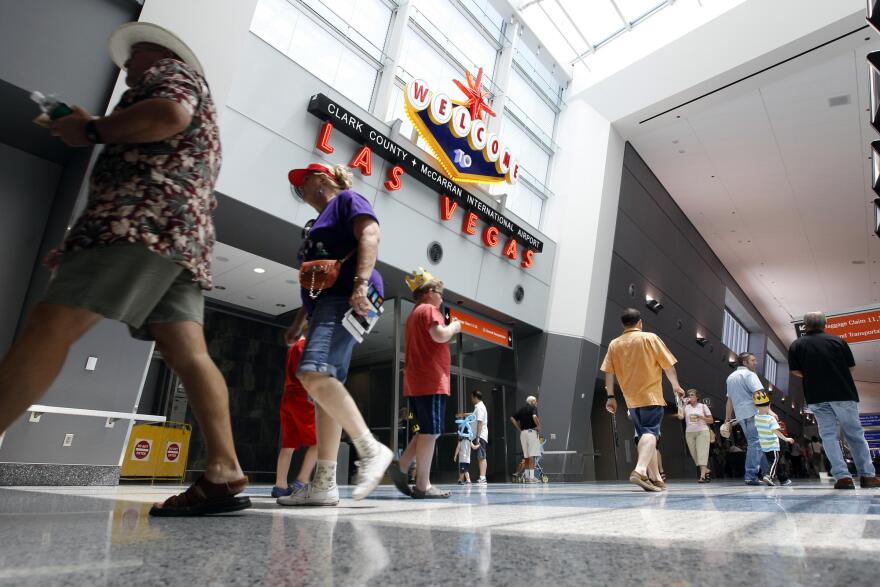In the last two months, Las Vegas has gone through the fear and panic of mass shootings, even though the shootings never happened.
It started in July: People at MGM Grand thought the sound of shattering glass was gunfire. Less than a week later, police received calls of gunfire and a shooter inside the Fashion Show Mall. The reality? A thief running away created a noise which shoppers believed to be gunfire.
And earlier this month, 338 flights were delayed and 53 were cancelled at Reid International Airport after a man hit something, created a loud noise and people thought it was gunfire.
So what’s causing us all to be so on edge? It’s easy to say it’s mass shootings in this country. Could it be misinformation on social media? Most users of Twitter check the platform first for news, according to Pew Research.
Good or bad, more people rely on sometimes spurious sources or the downright lies of social media for their news. They’d rather take the word of a friend, associate, relative or just someone with the same political beliefs over scientific fact over vetted and fact-checked news sources.
But is there a link between the reliance —or is it addiction— to social media and what we’ve seen in Las Vegas over the last few months?
Bloomfield said the more time spent on social media, the more likely one is to get into an echo chamber, where you see the same content the site believes you’re going to engage with. It can lead to showing the user more exaggerated or more extreme content.
“There is preliminary evidence that increased social media use is correlated with increased likelihood of PTSD,” she said. “And that people exposed to media related to disasters increase the likelihood of PTSD, even if people were not at that event. So there are ways to get sort of a vicarious PTSD from viewing really extreme media content.”
She said for relief, you can take a pause from news or social media, or balance consumption with content that is less extreme or less violent. Bloomfield noted violence in the media happens less frequently on a daily basis than we think, and considers social media an amplifier.
Without the ability to fact-check that information, on the ground and in the moment, that information can spiral out of control. She said often those who are posting misinformation aren’t realizing it’s false, or think they may be helping by spreading it.
In the MGM Grand scare, a photo of blood on the ground circulated Twitter, but was later found to have been a photo from an unrelated incident prior to that night.
“If someone is sharing misinformation, simply, ‘Oh no, I saw this on the floor of MGM casino, I heard the word gunshots. It makes sense to me that this might be related,’” Bloomfield said.
A survey by the American Psychological Association in 2019 found that more than three-quarters of adults (79%) in the U.S. say they experience stress as a result of the possibility of a mass shooting. In that same survey, nearly one in three adults feel they cannot go anywhere without worrying about being a victim of a mass shooting, while just about the same number say fear prevents them from going to certain places or events.
At the same time, the National Safety Council Found that 1 in 11,125 people will die in a mass shooting. About 1 in 15,000 people have a chance to get hit by lightning.
But when it comes to fear, Bloomfield said it’s a natural way to protect yourself and increase chances of survival. It only becomes problematic when overreactions result in a situation of mass panic, where the risk of injury is increased.
When that does happen, Benning said it’s a result of being unable to distinguish the threat.
“We've heard people talking about the shattering of glass, the knocking down of stanchions at the airport, these kinds of sounds straddle the boundary between our ability to tell ‘Is this a neutral sound or a threatening sound?’” Benning said. “And it's possible that with an increased tendency to be hypervigilant toward threats that people may experience … Some of those sounds that might normally be perceived as relatively neutral become perceived as threats, things that we have to act on immediately.”
Benning said the number of mass shootings plays a role, as they’ve risen in the U.S. over the past 20 years, as has media coverage of them. In 2019, there were 417 mass shootings. In 2021, there were 693.
“We have also become more aware of guns,” he said, noting concealed carry and open carry laws. “People who are prone to perceive places as potentially more threatening may also have the societal availabilities of threat in mind as part of the top-down justification for why they are more afraid to interact in public settings.”
But it’s not just mass shootings. In 2017 before the October 1 massacre, a stanchion fell at a nightclub following a big fight, causing a panic.
Mindfulness meditation is something that is often used to help people identify when they are experiencing particular kinds of sensation, Benning said. Prolonged exposure is another treatment, as part of EMDR therapy.
“But it is really unlikely that any of these kinds of interventions would reduce people's reactivity to threat so much that in the case of a real genuine threat to their lives, they would be unable to respond,” he said. “It isn't as if these kinds of therapies to help people reduce excessive reactivity to threats will make them so unreactive that in a situation where there's a genuine threat to life and limb, they won't respond.“
Both Benning and Bloomfield noted fear is what triggers our natural "fight or flight" response.
Stephen Benning, associate professor of psychology, UNLV; Emma Frances Bloomfield, assistant professor of communications studies, UNLV










